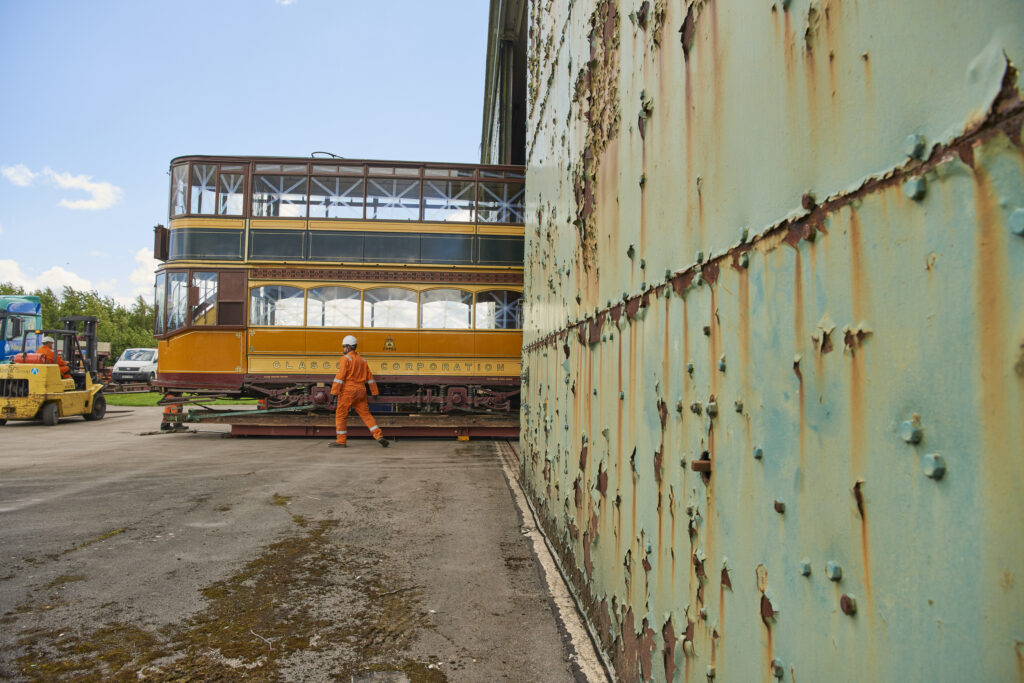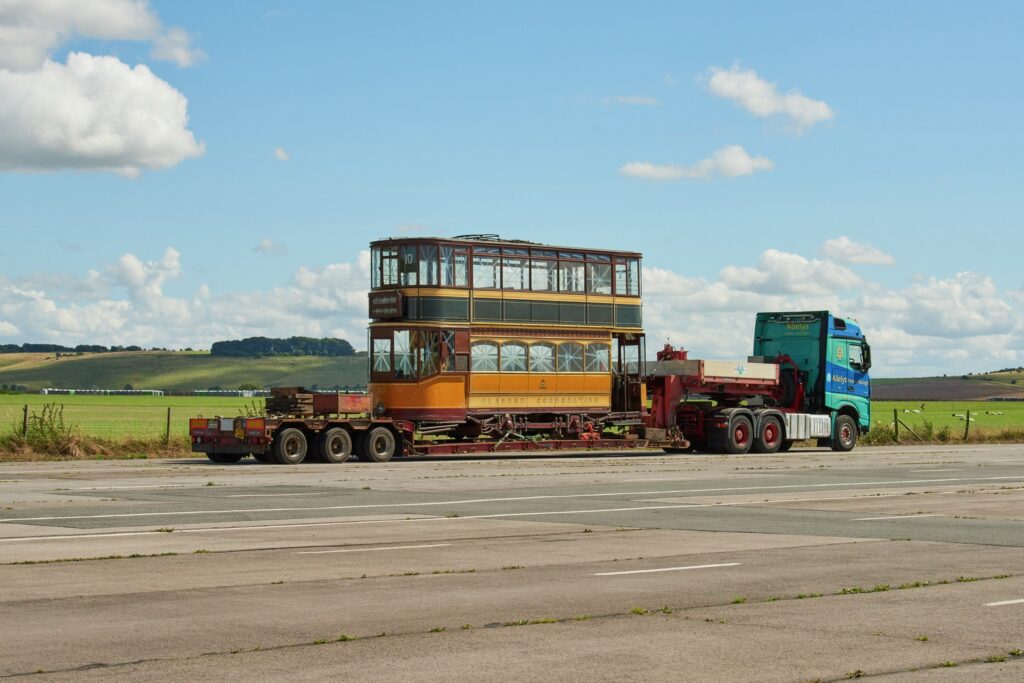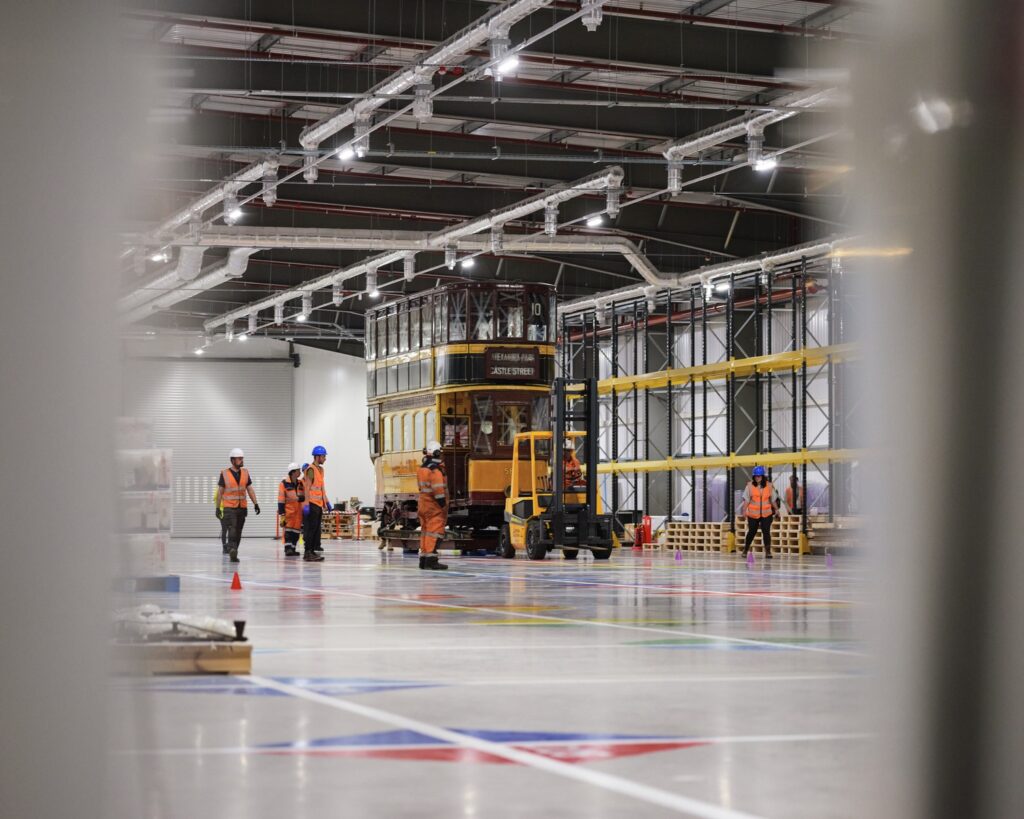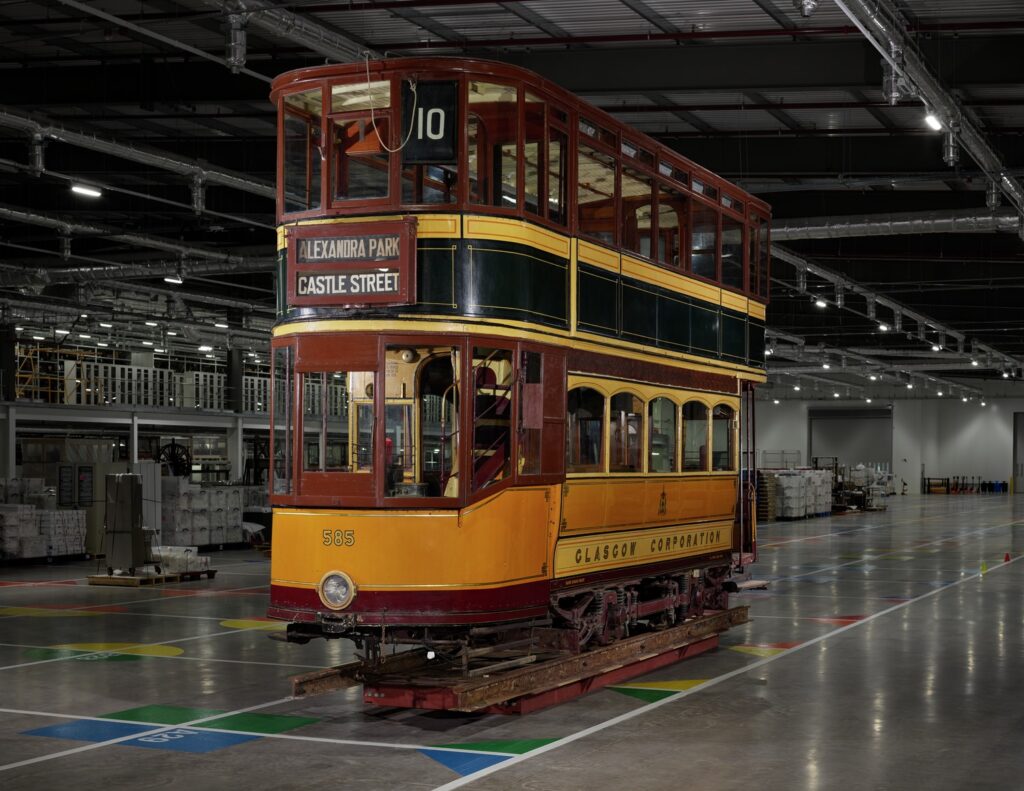When we moved Glasgow Corporation Tramcar No.585 into our vast new collection management facility in Wiltshire, it became the first large object to take up its position on the colourful grid. Measuring over 5 metres tall, it will be one of the biggest objects in the purpose-built facility. You can discover more about the tramcar’s move on YouTube.

Our Tram 585 is a four-wheeled standard car, the most common type found in Glasgow’s fleet from when they were electrified until the end of service. Over one thousand standard cars were built between 1898 and 1924, with the design modernising and improving over time – for instance, gaining a roof and becoming fully enclosed to protect from the weather.
This car was built with an open top in May 1901 and rebuilt with a roof in 1930. The rounded glazing of the tram’s dashboard and upper deck windows shows its age, as later cars that were built as new used cheaper flat panes of glass, giving them a hexagonal dashboard shape.
Scotland’s first tramway opened in Edinburgh in 1871 and Glasgow followed suit a year later. On 19 August 1872, passengers could swap a bumpy ride over cobblestones in horse-drawn omnibuses to glide on new tracks between St George’s Cross and Eglinton Toll aboard the first horse-drawn trams in the city.
A private company, the Glasgow Tramway and Omnibus Company operated the tram system at first. The number of routes the tramway system operated along grew over its lifetime until it was one of the largest urban systems in Europe, with routes covering over 100 miles.

By June 1894, the tramway was serving 54 million passengers a year, and by the end of the century Glasgow’s passengers made up a fifth of all people travelling by tram in both England and Wales combined. Glasgow Town Council took over service operation on 1 July 1894, as Glasgow Corporation Tramways, making Glasgow the first city in Great Britain to own and operate its own municipal tram service.
Glasgow’s fleet of almost four hundred horse-drawn trams needed thousands of horses to pull them, and the Corporation quickly turned to electricity. The Tramways Committee began an experimental electric route on 13 October 1898 and, following its success, continued to electrify the system until the horse-drawn service was completely withdrawn in April 1902. By this point, the tramways were transporting 20% of passengers across the whole of Scotland. The system was fully electrified at a time when electric lighting was still only just making its way into households.
At its peak, an estimated 97.8% of people in Glasgow used trams to get around, which was no mean feat: the densely populated and bustling city became one of the first in Europe to reach a million residents.
At one point, a city centre junction between Jamaica Street and Renfield Street had approximately 466 tram cars passing by every hour, which then rose to 516 on Saturdays. In the book Glasgow By Tram, Ian Stewart writes that the trams would run their routes in two-minute intervals, with one passing every 12.5 seconds in Renfield Street.

The outbreak of the First World War in 1914 led the tramways to raise a battalion to serve. General Manager James Dalrymple led the recruitment, gathering over one thousand volunteers who formed the 15th Highland Light Infantry, or Tramways Battalion.
The departure of these volunteers to join the war effort left the company extremely short-staffed. To mitigate the shortfall, women were trained up as conductors (or conductresses), an example that attracted the attention of other municipalities which began to follow suit.
Though Darlington beat Glasgow to employing women as tram drivers, it wasn’t long before Dalrymple began trialling this too, with one woman from each of the six depots beginning training in November 1915. All drivers, regardless of gender, must have had first completed 6-12 months’ work as a satisfactory conductor. By 1916, there were 1180 conductresses and 25 female drivers working on the tramways. They were largely given the same conditions as men, working long 51-hour weeks, often on top of family responsibilities.
Following the end of the war, Glasgow Corporation gave the tram driver roles back to men, as did many industries who laid off their female workforce to reinstate returning troops. However, they allowed women to remain working as conductresses, and a number of female drivers switched back to conductress roles. It would take the Second World War for women to be recruited once more.
Historically sexist views that women were not capable of taking on jobs such as driving trams meant that their employment was only considered as a last resort during wartimes when industries such as the tramways could not operate with reduced staff. Male colleagues were described as ‘too patriotic to raise any objection’.
Despite this fact, it was still an important milestone in the history of women in transport, especially as women across Britain were not permitted to drive commercial, passenger carrying buses until the 1970s. The majority of buses before the 1970s didn’t have power steering technology, meaning that a bus at capacity needed a great amount of strength to steer it. In comparison, trams are largely steered by their tracks. It’s been suggested that this might be why it took a further half a century for the change to extend beyond the tramways, although the Sex Discrimination Act of 1975 gives an idea of how long it took for views to begin to change.

The increasing popularity of motor cars and the inflexibility of a tramway – with its fixed rail routes – ultimately led to the service’s decline. In 1949 two tramlines were converted to run trolleybuses, and by 1953 the decision was made not to continue replacing the ageing tramcar fleet. This led to the tram system gradually phasing out to be replaced by trolleybuses and diesel buses, until the service was completely replaced by diesel buses less than twenty years later.
The move away from tramways to buses was a huge loss for female tram drivers in Glasgow who had to wait years until they were permitted to drive buses in the city. Glasgow Corporation first accepted women to train as bus drivers in 1971, however they still faced discrimination and pushback from male colleagues who protested against their employment.

The tramways closed on 4 September 1962, having served Glasgow’s public as an affordable transport option for ninety years. By this point, the only route left was the No. 9 Auchenshuggle to Dalmuir service.
The ‘last day’ of the trams was marked by a procession of twenty trams through the city between the depots at Dalmarnock and Coplawhill. The procession celebrated the history of the tramways, featuring trams new and old – some of which had been especially restored to their original designs.
In fact, the real last day of operational tram service had been three days prior, but this event marked a commemorative end to a long and faithful service that had survived two World Wars. The streets were awash with over 250,000 people who had turned out to see the procession, and many lay pennies on the track for keepsakes.
Glasgow’s tramway was the last surviving city tramway in Great Britain until modern systems were put in place, beginning with the Manchester Metrolink in 1992.
Our Tram 585 is now safe in its new purpose-built home. The new facility, part of the National Collections Centre at the Science and Innovation Park, is due to open in 2024 for public tours, school and research visits, enabling people to see the vast majority of the Science Museum Group Collection under one roof for the very first time. We can’t wait to show you around.

DISCOVER how we transported the glasgow tramcar to its new home:
This post was updated on 31 December 2024.
